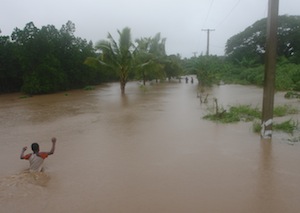
Speaking at last week’s SPC/SOPAC Division’s STAR meeting (17th-18th October) in Nadi, Dr Stephen Yeo, a flood risk management consultant from Australia said, “A disproportionately high number of those who have lost their lives in floods in Fiji are males, especially teenagers and young men aged 15 to 24 years, the median age being 23 years.”
The STAR (Science, Technology and Resources Network) meeting is an integral part of SOPAC’s first meeting as a Division since becoming a part of the Secretariat of the South Pacific Community (SPC) in January this year.
Although his research has been based on extreme weather and flooding events in Fiji, Dr Yeo, who has more than fifteen years of experience in flood risk assessment management, said his findings could have implications for other Pacific Island countries and territories.
Dr Yeo explained that deaths by drowning in floodwater came under two categories: active and passive.
Over the last decade, those deaths classified as ‘active’ account for 63% of deaths by drowning in floodwater, and are those where people have decided, for whatever reason, to enter the floodwater, usually on foot. ‘Passive’ deaths occur when, for example, people are trapped in a flooded home, or as in 2004 when a stationery bus was washed away. This category accounts for 37% of floodwater drowning deaths.
Although the reasons for entering floodwater may not be clear they do include trying to get to or from school, trying to get to or home from the plantation, or even after a yaqona (kava) session. It also includes children playing in the flood, and inadequate adult supervision.
Dr Yeo said that community education was key to preventing further loss of life during floods, and that clear, direct messages are necessary: Parents must supervise their children and ensure they do not play by a flooded river, drain or compound; don’t go swimming in a flood, don’t play close to a flooded creek, don’t enter floodwaters, don’t cross a flooded bridge, you could die!
“How can these messages be communicated? I am sure there are many here that are more qualified than me to speak on Fiji, but one way would be for young people to take ownership of the message, perhaps through song and poster competitions, in both the Fijian and Hindi languages, so that local people are seeing that message in their own storytelling medium.
“In terms of community education, evacuate to high ground certainly sounds like a common sense response. However, during Cyclone Ami in 2003, some people who died actually got into trouble during evacuation. Many survivors chose not to evacuate – but stayed in their houses – went up into their roof space and then made a hole in the roof and stayed on the apex of the roof.
“So we need to prompt two messages. Message number one, even before the floodwater arrives, evacuate early and message number two, if you are inside your house, stay there and shelter in the highest part of the building.”
Other factors contributing to safe and successful evacuation are: transport, so people are able to evacuate; security for homes, so that people are willing to evacuate; water safety, so people are competent around water.
Where safe evacuation cannot be carried out, communities may need to consider abandoning dangerous sites and relocating.
Although there are various initiatives underway in Fiji to improve official flood warning systems, Dr Yeo said that, in the main, people rely on informal unofficial warnings and their observation of indicators in their own environments.
“We tell people living on the coast, if you feel an earthquake, go to higher ground. That may be your only warning of the tsunami. Why don’t we also say, if you live next to a creek and you hear a tropical cyclone is coming go to higher ground. That might be your only warning of a flood.”
Dr Yeo said that flash flood warning systems and community-based evacuation planning are only a part of what needs to be a holistic management approach that also includes land use planning and building design.
Dr Yeo’s trip to Fiji is sponsored by Risk Frontiers at Macquarie University in Sydney, though he has undertaken this research in his own time, which grew out of the year he spent at SOPAC, 1999/2000.
Photo caption: Walking through flood water can result in drowning





